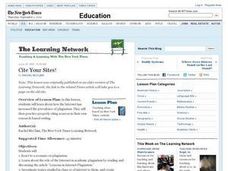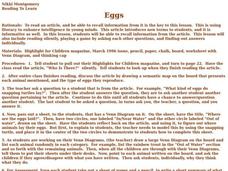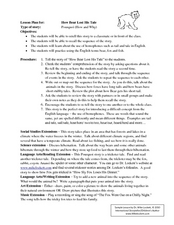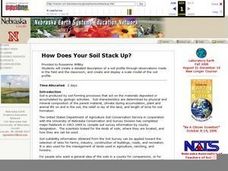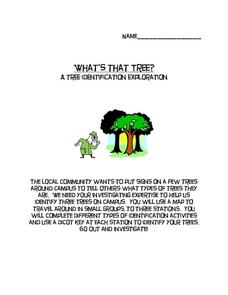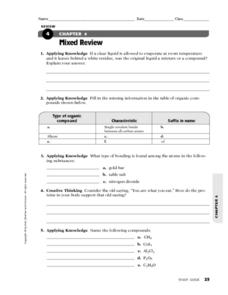Curated OER
Prewriting
As a class, 7th graders observe examples of brainstorming and then complete brainstorming worksheets themselves. They compose and describe planning strategies. Prior to writing an essay, they identify the purpose and the audience.
Curated OER
Technology Integration
Third graders describe and locate the five geographical regions of the state of Virginia. Using that information, they organize the descriptions in a database they created. They are graded based on accuracy and spelling all noted on a...
Curated OER
George Winter Lesson Plan 3
Bring language arts and U.S. history together in this lesson, which prompts middle and high schoolers to gather biographical information about Abraham Lincoln. They compare and contrast information written about his childhood and discuss...
Curated OER
Where Do I Live?
Students gain a better understanding of the population of the region they live in by comparing U.S. census data on the internet.
Curated OER
Cite Your Sites
What information would you find in an almanac that you would not find in an atlas? What is the difference between a dictionary and a thesaurus? Using a Cite Your Sites worksheet on which they record their observations, groups participate...
Curated OER
Eggs
Help your students practice reading an article to improve their literary skills with new terms and summarizing information. They read silently and then play a game by asking each other questions and finding out answers individually. A...
Curated OER
Windmills and Blogs: The Impact of Technology in Rural Peru
How does technology affect a community? Research the benefits and consequences of technology in rural Peru. In this technology lesson, learners discuss how the effects of technology. They view a PowerPoint and learn about the Peace...
Curated OER
Edgar Allan Poe's "The Cask of Amontillado"
After reading "The Cask of Amontillado" by Edgar Allan Poe, use the SMART board file to learn about Poe's background and use of irony. The lesson includes resource links to additional websites, as well as the SMART board file (you...
Curated OER
How Bear Lost His Tale: Storytelling
For this storytelling lesson, children practice re-telling the story of "How Bear Lost His Tale", review and write out the story sequence, and learn about homophones like tail/tale, sail/sale, etc. Extension activities for various...
Rocklin Unified School District
Spanish Speaking Countries Project
Ask your class members to provide a tour of a Spanish speaking country with a brochure and flag project. Learners research their assigned country, making sure to check off each of the required pieces of information listed on the first...
Curated OER
Town Along the Chesapeake Bay
Fourth graders make a drawing of a town along a river off of the Chesapeake Bay in Maryland. Upon completion, they give an oral description of their town, including its houses, stores, businesses, farm area, government, etc., and will...
Curated OER
Introducing NatureMapping
Pupils model the NatureMapping program in order to study habitats and biodiversity.
Curated OER
How Does Your Soil Stack Up?
Students examine the soil in their local area and create a soil profile. They record observations in the field and the classroom. They create their own display of the soil profile as well.
Curated OER
The Flow of Women's Work: How Cultures are Alike and Different?
Students examine gender roles in various cultures. In this flow of women's work lesson, students compare water related work in rural Africa to that in their own households.
Curated OER
Expanding the Story of the Montgomery Bus Boycott
Introduce the class to the Civil Rights Movement by taking a critical look at the Montgomery Bus Boycott in 1955. They will pay close attention to the role women played in organizing the boycott and bringing national attention to the...
Curated OER
Vocabulary: Multiple Meaning Words in Context
Learners use context clues to define words with multiple meanings. After extensive practice with their teacher, learners read through six sentences, they then identify a word with a multiple meaning, and determine its meaning based on...
Curated OER
American Indians
Eighth graders discuss their country of origin and form work groups based on their answers. In this American Indian lesson, 8th graders locate their country of origin to the lifestyle, products and living arrangements...
Curated OER
What Lives in the Open Ocean and Where Do They Live?
Young scholars explore oceanography by participating in a flash card activity. In this ocean inhabitant instructional activity, students define a list of ocean related vocabulary terms and answer ocean geography study questions. Young...
Curated OER
Weather Reporter
Fourth graders generate an oral presentation on the weather. In this weather lesson, 4th graders watch the weather for a week and record the data on a chart. Students give a weather report at the end of the week.
Curated OER
What's That Tree?
Fifth graders identify trees along a nature trail. Using a dichotomous key, 5th graders answer questions to aid in their identification of trees along a specified nature trail. Observations are recorded in their science journals. Sample...
Curated OER
Name That Tune
Students complete a fingerprint oil lab in order to simulate how geologists use the oil and natural gas in rocks to hear sound waves that signify there are oil in those rocks. In this rocks lesson plan, students learn that the rock...
Curated OER
Christopher Columbus, The Explorer
Students brainstorm important facts about Christopher Columbus, input information into Kidspiration or Inspiration, watch United Streaming Video on Christopher Columbus and New World to gather information, research online to find...
Curated OER
Predicting Storms and Weather
Young scholars use weather pattern worksheets to research how weather is predicted. In this weather prediction lesson plan, students predict the weather based on the wind, rain, currents, and other patterns.
Curated OER
Mixed Review
In this chemistry worksheet, students solve chemical equations and define terminology using previous knowledge. There are 8 review questions.




